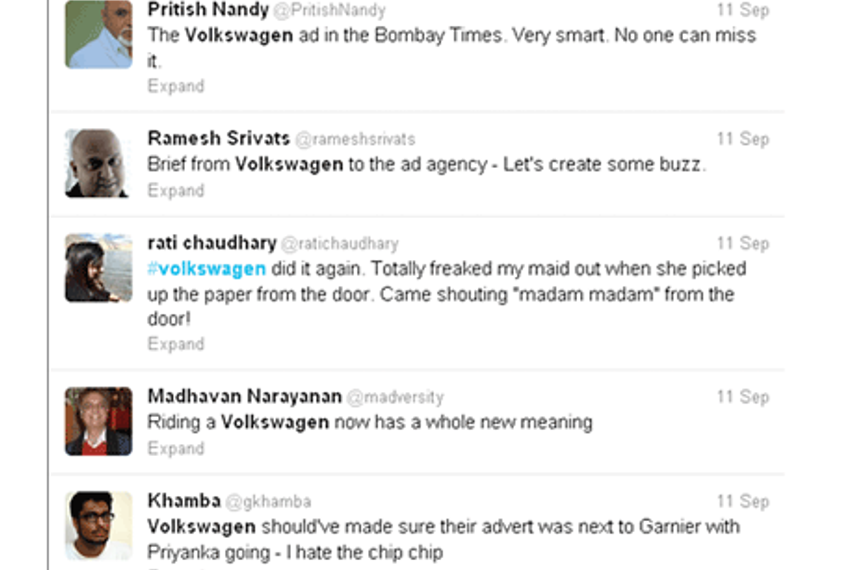
It is quite evident that Volkswagen, one of the world’s premier automakers, has adopted a ‘disruptive’ marketing strategy to capture a highly competitive Indian market in which they were seen as a late entrant. In 2009, Volkswagen launched in India with a marketing blitzkrieg as it tried to build brand awareness.
Going by its international reputation, the idea was clear and simple: ‘To be innovative in marketing communications’. From that standpoint, the talking newspaper made sense, and it did manage to become the talk of the town. But its recent attempt with The Times of India, Hindustan Times and The Hindu (vibrating/buzzing newspaper) has evoked varied reactions. And it was not so long ago that coffee brand Bru Gold experimented with the ‘aroma innovation’. Are we seeing one innovation too many in print, and are the ‘innovations’ innovative enough?
Arun Anant, CEO, Kasturi & Sons (publishers of The Hindu), defends the spirit of innovation. He reflects, “Innovations are carried out to break the clutter and surprise the prospective customer. It is done to derive maximum value and I believe that every business should spend time innovating.”
On the premise that increasing number of similar innovations may impact the ‘value’ of innovations, Anant maintains that the value of innovations is unlikely to falter if the surprise element is taken care of.
Talking of a slew of innovations in the recent past, Shripad Kulkarni, chief executive officer, Allied Media, said, “Ideas per se, innovations such as the talking newspaper, aroma, and the buzzing newspaper deserve on a pat on the back for executing innovations on a big scale. But, these are times of genuine, engaging connect with consumers. In today’s social and mobile world, the likeability and receptivity of all connections is far more important than pure noticeability of the good old days. The fundamentals like ‘the innovation reflecting the brand essence’ will never change. I think quite a few innovations falter here.”
He further adds, “The latest innovation by Volkswagen (buzzing newspaper)… I’m not quite sure of the likeability, receptivity and even the residual messaging of brand essence.”
According to Ajay Kakar, CMO - financial services, Aditya Birla Group, the purpose of any advertisement is to attract the attention of the prospective customer and every marketer has to remember that consumers don’t wait in anticipation for brands to talk to them.
He says, “The first challenge is always to catch the eye of your consumer from the clutter. And that’s where ‘innovation’ plays a critical role.”
Kiran Khalap, co-founder, chlorophyll brand and communications consultancy, believes that ‘innovations’ like Volkswagen’s talking newspaper and now the vibrating newspaper suit the announcement of a new product launch better. To some extent, the new variants (of Polo and Vento) qualify as new launches, but Khalap isn’t sure the vibrating paper was the best approach.
From another tangent, is the industry running out of ideas for print innovations? Manish Bhatt, co-founder, Scarecrow Communications, observes, “If the innovation becomes predictable, then it has no value.”He further adds, “There is no shortcut in creativity. You can’t buy creative communication ideas from electronic gadget stores. Every time you do that from now, you are not going to surprise the reader.”
Vinay Bhatia, senior vice president, marketing and loyalty, Shoppers Stop, points out that the base premise of print innovations is to generate buzz, create a lasting impact, and get a bigger bang for advertising buck. He adds, “And, if the idea is convincing and appealing enough to the customer, a direct correlation to sales is a definite possibility. Having said that, there should be a clear linkage between the print innovation and the product offering.”
He cites the example of an Augmented Reality code the retailer embedded in its print ads for an end of season sale. “Using this, readers could view certain ‘hidden offers’; click on them, and be directed to our website to place an order of that product. It really worked well for us,” he explains.
The Hindu’s Anant notes that the hunt for newer ideas is good. He says, “The best innovations come up when the mind blocks itself to old ideas. If a planner runs out of innovation ideas, that is when he is most likely to come up with something stunningly different.”

Media agency
Shripad Kulkarni, chief executive officer, Allied Media
“In today’s social and mobile world, the likeability and receptivity of all connections is far more important than pure noticeability of the good old days. The fundamentals like ‘the innovation reflecting the brand essence’ will never change.
I think quite a few innovations falter here.”

Creative agency
Manish Bhatt, co-founder, Scarecrow Communications
“There is no shortcut in creativity. You can’t buy creative communication ideas from electronic gadget stores. Every time you do that from now, you are not going to surprise the reader.”

Marketer
Ajay Kakar, chief marketing officer - financial services, Aditya Birla Group
“If variety is the spice of life, it is the duty of the brand team, which is the client, creative agency and the media agency to find newer ways to catch the attention of the reader with a new trick every time.”

Marketer
Vinay Bhatia, senior vice president, marketing and loyalty, Shoppers Stop
“If the idea is convincing and appealing enough to the customer, a direct correlation to sales is a definite possibility. Having said that, there should be a clear linkage between the print innovation and the product offering.”

Publisher
Arun Anant, chief executive officer, Kasturi & Sons
“The best innovations come up when the mind blocks itself to old ideas. If a planner runs out of innovation ideas, that is when he is most likely to come up with something stunningly different.”






.jpeg&h=268&w=401&q=100&v=20250320&c=1)
.png&h=268&w=401&q=100&v=20250320&c=1)
.png&h=268&w=401&q=100&v=20250320&c=1)

